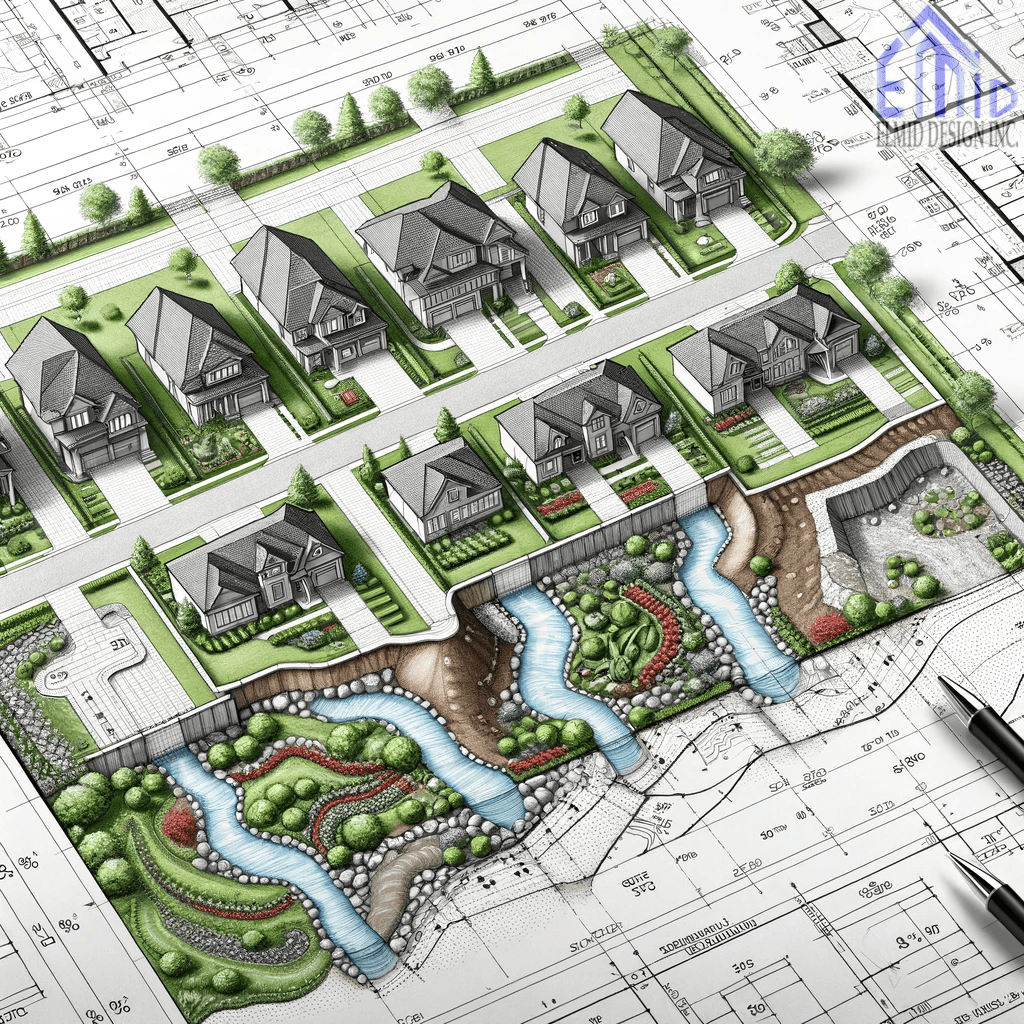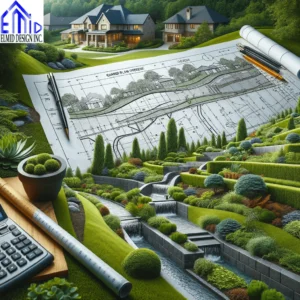Introduction
Grading plans are pivotal for any construction or civil engineering project, setting the foundation for successful site development. These plans not only ensure compliance with local codes and regulations but also address critical aspects like drainage, soil stability, and environmental protection. Understanding grading plan requirements is essential for engineers, developers, and architects to navigate the complexities of land development and infrastructure projects effectively.
[toc]
Key Takeaways
- Grading plans are essential for managing water runoff, soil erosion, and ensuring structural stability.
- Detailed components like contours, elevations, and stormwater management features must be meticulously outlined.
- The approval process involves several steps, including plan preparation, submission, and review by local authorities.
Ontario Grading Plan Requirements
Provincial Regulations
While overarching provincial regulations exist, it’s crucial to remember that Ontario municipalities often have their own specific sets of grading plan requirements. Be sure to research the precise rules in your project’s location.
Municipal Bylaws and Ordinances
Municipal bylaws dictate factors like:
- Minimum and maximum allowable slopes
- Setbacks from property lines
- Drainage patterns and swale requirements
- Erosion and sediment control measures
Understanding Grading Plans
Grading involves reshaping the land to achieve desired topography for construction projects. It’s a critical step in preparing a site for development, affecting drainage, foundation integrity, and landscape aesthetics. Grading plans, thus, detail how the land will be modified, illustrating slopes, elevations, and other land-altering activities.
Purpose and Need
- Why Grading Plans are Necessary: To ensure safe and sustainable land development that complies with local regulations and supports intended land use.
- When a Grading Plan is Required: For new constructions, land developments, or any project altering the existing topography.
Types of Grading
- Architectural Grading: Shapes the land for buildings and infrastructure, focusing on aesthetics and functionality.
- Regrading: Modifies existing landscapes to correct issues like poor drainage or erosion.
- Finished Grade: Refers to the final elevation and contour of the land after grading is complete, crucial for landscaping and construction.
Components of a Grading Plan
A comprehensive grading plan includes several critical components, each serving a unique purpose in land development and project planning.
Essential Elements
- Title Block and North Arrow: Identifies the project and provides orientation.
- Scale Bar and Proposed Contours: Offers a detailed view of proposed land modifications.
- Spot Elevations and Sections: Show specific heights and cross-section views of the terrain.
- Stormwater Management Features: Details on how water runoff will be managed to prevent erosion and flooding.
Tools and Software
- AutoCAD Civil 3D: A popular tool for creating detailed grading plans, offering features for modeling terrain, calculating volumes, and drafting detailed drawings.
Grading Plan Approval Process
Obtaining approval for a grading plan is a multi-step process that involves meticulous preparation and adherence to local regulations.
Steps for Approval
- Preparation: Gathering all necessary documents and ensuring the plan meets all local requirements.
- Submission: Presenting the plan to the relevant authorities for review.
- Review and Approval: The plan is examined by officials, and feedback or approval is provided.
FAQs
What is Grading and Why is it Important? Grading is the process of modifying the land’s surface to meet design requirements for construction, addressing issues like drainage and soil stability.
How Do I Ensure My Grading Plan Meets Local Requirements? Consult local building codes, engage with professional engineers, and possibly review past approved projects to understand standards and expectations.
Common Pitfalls in Grading Plan Preparation
- Overlooking local regulations and environmental constraints.
- Failing to account for natural water flow, leading to potential flooding or erosion issues.
Conclusion
A well-prepared grading plan is crucial for the success of any construction project, ensuring that the land is suitably prepared to support the proposed development. By adhering to local codes, focusing on detailed plan components, and following the approval process diligently, project stakeholders can mitigate risks and pave the way for smooth project execution.
For professionals and stakeholders involved in land development and construction, mastering the intricacies of grading plans is not just about regulatory compliance—it’s about laying the groundwork for safe, sustainable, and successful projects.

Implementing Grading Plans
After obtaining approval for a grading plan, the focus shifts to the implementation phase. This stage involves precise execution according to the approved specifications to ensure the intended outcomes are achieved.
Best Practices for Grading Implementation
- Coordination with Professionals: Collaborate closely with civil engineers, surveyors, and construction teams to adhere to the plan’s specifications.
- Monitoring and Adjustments: Regularly monitor progress and make necessary adjustments in response to unforeseen challenges or site conditions.
Technologies and Tools
- Advanced Surveying Equipment: Utilize GPS and laser-guided surveying tools for accurate grading.
- Software Solutions: Employ project management and CAD software for real-time monitoring and adjustments.
Monitoring and Compliance
Ensuring that grading activities comply with the approved plan and local regulations is critical for the success of the project and for minimizing environmental impact.
Inspection and Reporting
- Scheduled Inspections: Conduct regular inspections by licensed professionals to verify compliance with the grading plan.
- Compliance Reporting: Prepare and submit compliance reports to local authorities as required, detailing the grading activities and any deviations from the plan.
Environmental Considerations
- Erosion and Sediment Control: Implement measures to prevent erosion and manage sediment during and after grading activities.
- Water Quality Management: Address runoff and water quality through best management practices (BMPs) to protect local waterways.
Long-term Management of Graded Sites
The responsibility of managing a graded site extends beyond the completion of grading activities. Long-term strategies are essential for maintaining site stability, functionality, and environmental compliance.
Landscaping and Reclamation
- Sustainable Landscaping: Incorporate native vegetation and landscaping techniques that complement the grading design and contribute to soil stabilization.
- Site Reclamation: For sites that have undergone extensive grading, implement reclamation practices to restore natural habitats and reduce environmental impact.
Ongoing Maintenance
- Drainage System Maintenance: Regularly inspect and maintain drainage systems to ensure they function as designed.
- Soil Stability Monitoring: Conduct periodic assessments of soil stability and implement corrective measures as needed.
FAQs
How Often Should Graded Sites Be Inspected for Compliance? Inspection frequency may vary based on local regulations and project specifics but typically should occur at critical milestones during construction and periodically thereafter.
What Are Common Challenges in Grading Plan Implementation? Common challenges include unexpected subsoil conditions, weather-related delays, and compliance with evolving environmental regulations.
How Can Environmental Impact Be Minimized in Grading Projects? Minimizing environmental impact involves careful planning, implementing BMPs for erosion and sediment control, preserving existing vegetation where possible, and adhering to local environmental guidelines.
Conclusion
Effective grading plan requirements, implementation, and long-term management are crucial for the success of construction and development projects. By focusing on precision in planning and execution, compliance with regulations, and commitment to environmental stewardship, developers and engineers can ensure that their projects are sustainable, functional, and beneficial to the community.

Grading Plan Requirements in Ontario: A Comprehensive Guide
Introduction
Navigating the world of grading plan requirements in Ontario can feel like tackling an enormous, muddy hill. Between stringent regulations, the need for proper drainage, and potential environmental concerns, it’s easy to feel overwhelmed. But fear not! This guide cuts through the complexities, ensuring your construction project gets off to a rock-solid start. Whether you’re a homeowner tackling a renovation or a developer undertaking a large-scale project, we’ll break down everything you need to know about grading plans in Ontario.
Table of Contents
- What is a Grading Plan?
- Ontario Grading Plan Requirements
- The Grading Plan Preparation Process
- Submission and Approval of Your Grading Plan
- Common Challenges with Grading Plans
- Elmid Design Inc: Your Grading Plan Experts
- Frequently Asked Questions About Grading Plans
- Conclusion
What is a Grading Plan?
Definition and Purpose
Simply put, a grading plan is a blueprint for reshaping the earth! It meticulously outlines the existing and proposed elevations of your property. A well-crafted grading plan serves several critical purposes:
- Drainage Control: Directs the flow of water away from structures, preventing flooding and foundation damage.
- Erosion Prevention: Stabilizes slopes and mitigates soil loss.
- Site Preparation: Creates a suitable base for buildings, driveways, and other features.
- Compliance: Ensures the project adheres to local bylaws and provincial regulations.
Importance for Construction Projects
In short, a detailed grading plan is the bedrock of any successful construction project in Ontario. It protects your investment, minimizes environmental risks, and ensures a smooth building process.
Ontario Grading Plan Requirements
Provincial Regulations
While overarching provincial regulations exist, it’s crucial to remember that Ontario municipalities often have their own specific sets of grading plan requirements. Be sure to research the precise rules in your project’s location.
Municipal Bylaws and Ordinances
Municipal bylaws dictate factors like:
- Minimum and maximum allowable slopes
- Setbacks from property lines
- Drainage patterns and swale requirements
- Erosion and sediment control measures
Key Elements of a Grading Plan
A typical grading plan in Ontario must include:
- Property boundaries and existing features: Buildings, trees, etc.
- Existing and proposed contours: Demonstrated through topographic lines.
- Drainage systems: Swales, ditches, catch basins, and stormwater management strategies.
- Erosion control measures: Silt fences, berms, etc.
- Calculations and supporting documentation: May include soil reports.
The Grading Plan Preparation Process
Hiring a Qualified Engineer
Developing a grading plan that meets Ontario’s standards requires the expertise of a licensed civil engineer. They possess specialized knowledge of hydrology, soil mechanics, and regulations. Partnering with a reputable firm like Elmid Design Inc., certified by Professional Engineers Ontario (PEO), is an investment that significantly streamlines your project.
Site Survey and Analysis
Thorough preparation is key! The engineer begins by conducting a site survey to collect accurate topographic data. They also analyze existing drainage patterns, soil types, and environmental factors.
Developing the Design
The design phase is where your engineer works their magic! They utilize the collected data to craft a grading plan that achieves your project goals while remaining compliant. Here are key considerations:
- Drainage Considerations: Water must be channeled safely away from buildings and neighboring properties. Your engineer might plan for swales, culverts, and retention ponds.
- Erosion and Sediment Control: Environmental protection is paramount. The plan outlines strategies to prevent soil erosion and runoff during and after construction.
Submission and Approval of Your Grading Plan
Permit Applications
In most Ontario municipalities, you’ll need to submit your grading plan for review and obtain a permit before breaking ground. The application process often involves submitting your plan alongside supporting documentation.
The Grading Certificate
After construction work aligns with the approved grading plan, an engineer prepares a grading certificate. Let’s dive into this critical document:
- Purpose: The grading certificate officially verifies that the grading has been carried out in accordance with the approved plan. It’s often a requirement for obtaining an occupancy permit or releasing construction securities.
- Issuing Authority: Typically, the same engineer who designed the grading plan will issue the grading certificate. In Ontario, they must be licensed with Professional Engineers Ontario (PEO).
- Content: The grading certificate typically includes:
- Confirmation that the work was completed per the approved grading plan
- Statements addressing drainage, slopes, and erosion control measures
- As-built drawings, reflecting any minor adjustments made during construction
- Importance: The grading certificate offers peace of mind, demonstrating that your project is not only safe but also compliant with regulations. Elmid Design Inc. ensures seamless preparation and submission of grading certificates, taking the stress off your shoulders.
Review and Inspection Processes
Municipal officials meticulously scrutinize your submitted plan, ensuring adherence to regulations and the safety of your project. Be prepared for potential revisions during this stage. Once approved, inspections may be conducted at various phases of construction to verify compliance with the plan.
Common Challenges with Grading Plans
Navigating Complex Regulations
Staying on top of constantly evolving regulations is no small feat. A misstep can significantly slow down your project and even incur costly fines. Hiring a qualified engineer like those at Elmid Design Inc. helps prevent delays and ensure your plan aligns perfectly with Ontario standards.
Ensuring Design Accuracy
Even the smallest inaccuracy in a grading plan can lead to major headaches down the road – drainage issues, unstable slopes, or disputes with your neighbors. Partnering with certified professionals like those at Elmid Design Inc. minimizes the risk of errors and protects your project.
Mitigating Environmental Impacts
Grading activities can disrupt ecosystems if not carefully managed. A responsible grading plan prioritizes conservation by minimizing tree removal, protecting natural drainage systems, and controlling erosion. Elmid Design Inc.’s commitment to sustainable practices sets your project on the right path.
Elmid Design Inc: Your Grading Plan Experts
If you’re feeling overwhelmed by the prospect of your grading plan, rest assured, you’re not alone! Elmid Design Inc. is here to guide you through the entire process. Our team of engineers, certified by Professional Engineers Ontario (PEO), excels in designing precise and compliant grading plans. From initial site surveys to securing permits, we partner with you to achieve your project goals while minimizing environmental impact. Let us simplify the complexities of grading for you. Contact Elmid Design Inc. today for a consultation.
Frequently Asked Questions About Grading Plans
- Q: How much does a grading plan cost? A: Costs vary based on the project’s size and complexity.
- Q: How long does the grading plan approval process take? A: Review times vary by municipality. Factor this into your overall project timeline.
- Q. Are there any environmental permits required aside from the grading plan? A: This depends on the project’s size and location. Your engineer can advise.
Conclusion
Understanding grading plans is integral to your Ontario construction project. This comprehensive guide helps you confidently take the first steps. By prioritizing the right design, adhering to regulations, and partnering with Elmid Design Inc., you can ensure your project stands on a solid foundation, protecting your investments and ensuring long-term success.
Geographic Locations That We Service:
Our Licensed Professional Engineers specializing in Engineered Site Grading Plans offer the best-engineered site grading plan, lot grading and erosion plan, and drainage plan to obtain site plan approval and building permits in Ontario, including a wide range of municipalities. Each area boasts unique features and requirements, making our tailored approach essential for success.
Toronto and Surrounding Areas
In the vibrant heart of Ontario, we service Toronto (City of Toronto) and surrounding areas. Additionally, we cover Oshawa (City of Oshawa), Pickering (City of Pickering), and Clarington (Municipality of Clarington). Furthermore, our expertise extends to Ajax (Town of Ajax), Whitby (Town of Whitby), Brock (Township of Brock), Scugog (Township of Scugog), and Uxbridge (Township of Uxbridge).
Halton Region
Moving to the Halton Region, our services encompass Burlington (City of Burlington) and Halton Hills (Town of Halton Hills). Also included are Milton (Town of Milton) and Oakville (Town of Oakville).
Peel Region
In the Peel Region, we provide services in Brampton (City of Brampton), Mississauga (City of Mississauga), and Caledon (Town of Caledon).
York Region
Our services in the York Region cover Vaughan (City of Vaughan), Aurora (Town of Aurora), and East Gwillimbury (Town of East Gwillimbury). We also cater to Georgina (Town of Georgina), Markham (City of Markham), Newmarket (Town of Newmarket), Richmond Hill (City of Richmond Hill), Whitchurch-Stouffville (Town of Whitchurch-Stouffville), King (Township of King), and Bradford-West Gwillimbury (Town of Bradford-West Gwillimbury). Each municipality here offers a distinct setting, requiring our specialized approach.
Other Southern Ontario Cities and Towns
We also serve many other cities and towns in Southern Ontario. These include Hamilton (City of Hamilton), St. Catharines (City of St. Catharines), Niagara on the Lake (Town of Niagara on the Lake), Brant (County of Brant), Cambridge (City of Cambridge), Kitchener (City of Kitchener), Waterloo (City of Waterloo), and Woodstock (City of Woodstock). Furthermore, we operate in Guelph (City of Guelph), Centre Wellington (Township of Centre Wellington), Shelburne (Town of Shelburne), Orangeville (Town of Orangeville), New Tecumseth (Town of New Tecumseth), Essa (Town of Essa), Collingwood (Town of Collingwood), Wasaga Beach (Town of Wasaga Beach), Barrie (City of Barrie), Midland (Town of Midland), Orillia (City of Orillia), Ramara (Town of Ramara), Minden Hills (Town of Minden Hills), North Kawartha (Town of North Kawartha), Kawartha Lakes (City of Kawartha Lakes), Peterborough (City of Peterborough), Selwyn (Town of Selwyn), and Brighton (Municipality of Brighton).
We'd love to hear from you
Get in touch with us
Tell us about yourself by completing the form below. Your information is always kept confidential.
Reach us through
-
13025 Yonge St, Unit # 201G, Richmond Hill, ON, L4E 1A5 - +1 647 745 4507
- info@elmid.ca
Send us a Message
Elmid Design Inc.
Suite 201G,
Email: info@elmid.ca
URL: https://www.elmid.ca/
| Monday | 9:00 AM - 5:00 PM |
| Tuesday | 9:00 AM - 5:00 PM |
| Wednesday | 9:00 AM - 5:00 PM |
| Thursday | 9:00 AM - 5:00 PM |
| Friday | 9:00 AM - 5:00 PM |
| Saturday | Closed |
| Sunday | Closed |





